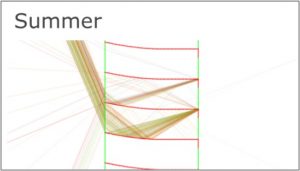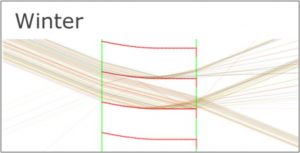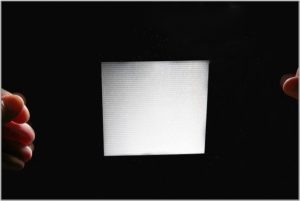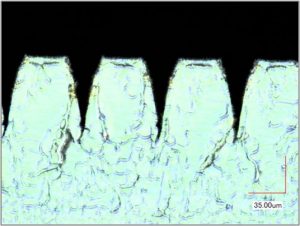The advanced glazing system under development by the group “Nanotechnology for Solar Energy Conversion” combines several functions and can contribute to significantly reduce the energy consumption in buildings with favourably oriented glass façades. In winter, solar gains are used to reduce heating energy requirements; in summer, the proposed device blocks direct radiation and thus limits air conditioning load as well as overheating risks (see Fig.1) [GON2016]. Judicious use of daylighting furthermore reduces energy needs for artificial lighting and improves the wellbeing of occupants. Our system is based on optical microstructures, and ensures transparency. Produced as a polymer film, the described glazing system will allow easy and low-cost integration into conventional double glazing.
The novel glazing will combine several functions:
- daylighting: redirection of incident radiation, projection of daylight deep into the room.
- glare protection/visual comfort: protection from direct solar radiation. Minimal impact on vision of the outside.
- overheating protection in summer: angular dependent solar transmission, most effective blocking at incidence angles occurring in summer for direct solar radiation.
- thermal insulation and solar gains in winter: The glazing shall provide maximum solar gains in winter in order to reduce heating loads. Integration of a film in a double-glazing window with a low emissivity thin film coating provides thermal insulation.
The optical microstructures can be originated by laser ablation (see Fig. 2) and replicated by cost-efficient roll-to-roll processing [GON2018a],[GON2018b].
PhD theses in this domain:
J. Gong, title of PhD thesis: Glazing with novel embedded optical microstructures for seasonal thermal dynamics, daylighting, glare protection and clear view, in various locations and climates, EPFL PhD Thesis No. 9390, thesis director Prof. J.-L. Scartezzini, codirector A. Schüler (2019)
A. Kostro, Miocrostructured Glazing for Daylighting, Glare Protection, seasonal thermal control and clear view, EPFL PhD Thesis No. 6465, thesis director Prof. J.-L. Scartezzini, codirector A. Schüler (2015)
Award
Best paper award in non-imaging optics SPIE 2018
SPIE Optical Engineering & Applications Conference of 19-20 August 2018, in San Diego, CA, USAJ. Gong, A. Kostro, J.-L. Scartezzini, A. Schüler, Feasibility study on a novel daylighting system with embedded micro compound parabolic concentrators (CPCs), (2018) Proceedings of SPIE – The International Society for Optical Engineering, 10758, art. no. 1075807
https://doi.org/10.1117/12.2320478
Internet links EPFL News:
https://actu.epfl.ch/news/spie-non-imaging-optics-best-paper-award-to-jing-g/
https://actu.epfl.ch/news/an-innovative-window-system-earns-a-european-pat-2/
Selected references
[GON2018a] Gong, J., Delaunay, A., Kostro, A., Schüler, A., Development of a novel mechanical micro-engraving method for the high-aspect-ratio microstructures of an advanced window system, (2018) Microelectronic Engineering, 191, pp. 48-53
https://doi.org/10.1016/j.mee.2018.01.032
[GON2018b] Gong, J., Kostro, A., Scartezzini, J.-L., Schüler, A., Feasibility study on a novel daylighting system with embedded micro compound parabolic concentrators (CPCs), (2018) Proceedings of SPIE – The International Society for Optical Engineering, 10758, art. no. 1075807
https://doi.org/10.1117/12.2320478
[GON2016] Gong, J., Kostro, A., Motamed, A., Schueler, A., Potential advantages of a multifunctional complex fenestration system with embedded micro-mirrors in daylighting, (2016) Solar Energy, 139, pp. 412-425
https://doi.org/10.1016/j.solener.2016.10.012


Fig. 1 : Ray-tracing simulation of microstructured glazing. [GON2016]
- In winter, direct sun light is redirected in the depth of the office room, resulting in energy savings in heating and electric lighting.
- In summer, direct sun light is reflected back to the sky, resulting in energy savings in air conditioning.


Fig. 2: Fabrication of microstructured glazing.
- A master mould is produced by excimer laser ablation of a polycarbonate substrate.
- A microstructure is replicated in UV-curable hyperbranched polymers. The following fabrication steps are tilted evaporation of mirror coatings on selected facets, and encapsulation.